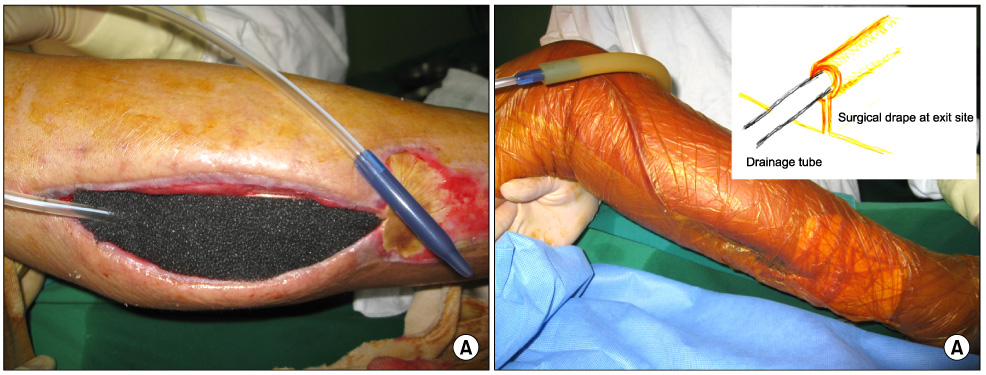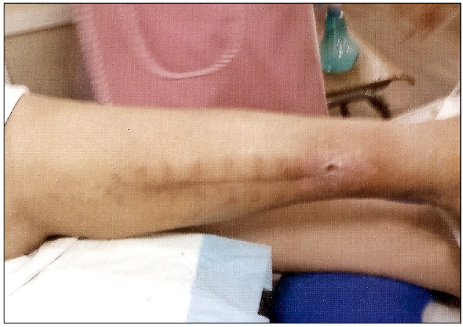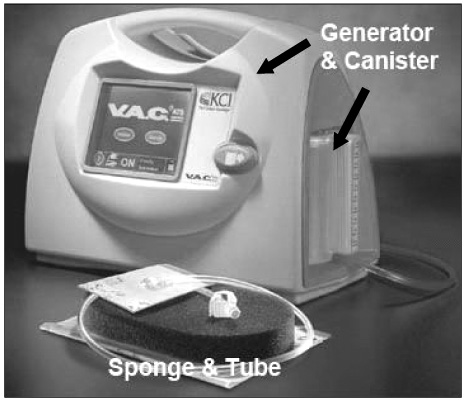J Korean Surg Soc.
2009 Dec;77(Suppl):S25-S28. 10.4174/jkss.2009.77.Suppl.S25.
Successful Closure of Fasciotomy Wound by Application of Topical Negative Pressure
- Affiliations
-
- 1Department of Surgery, Gil Hospital, Gachon University of Medicine and Science, Incheon, Korea. Kbirdie@gilhospital.com
- KMID: 1464798
- DOI: http://doi.org/10.4174/jkss.2009.77.Suppl.S25
Abstract
- Fasciotomy wounds are a major contributor to prolonged hospital stay and can lead to amputation. Although it is generally recommended to close the fasciotomy wound as early as possible, it is usually challenging. Primary closure is more favorable because it commences more functional and esthetic results with less morbidity. But primary closure is difficult to achieve due to skin edema, retraction and necrosis. Topical negative pressure care (TNP) has been used in other areas of wound care, such as mediastinitis and burn wounds. TNP has recently gained popularity and has shown promising outcomes. Topical negative pressure systems are commercially available but very expensive. We designed a modified negative pressure system with wall-suction and applied it to a complicated fasciotomy wound. We herein report our experience with a review of related literatures.
Keyword
Figure
Reference
-
1. Morykwas MJ, Faler BJ, Pearce DJ, Argenta LC. Effects of varying levels of subatmospheric pressure on the rate of granulation tissue formation in experimental wounds in swine. Ann Plast Surg. 2001. 47:547–551.2. Plikaitis CM, Molnar JA. Subatmospheric pressure wound therapy and the vacuum-assisted closure device: basic science and current clinical successes. Expert Rev Med Devices. 2006. 3:175–184.3. Morykwas MJ, Argenta LC, Shelton-Brown EI, McGuirt W. Vacuum-assisted closure: a new method for wound control and treatment: animal studies and basic foundation. Ann Plast Surg. 1997. 38:553–562.4. Braakenburg A, Obdeijn MC, Feitz R, van Rooij IA, van Griethuysen AJ, Klinkenbijl JH. The clinical efficacy and cost effectiveness of the vacuum-assisted closure technique in the management of acute and chronic wounds: a randomized controlled trial. Plast Reconstr Surg. 2006. 118:390–400.5. Vuerstaek JD, Vainas T, Wuite J, Nelemans P, Neumann MH, Veraart JC. State-of-the-art treatment of chronic leg ulcers: A randomized controlled trial comparing vacuum-assisted closure (V.A.C.) with modern wound dressings. J Vasc Surg. 2006. 44:1029–1038.6. Moues CM, Vos MC, van den Bemd GJ, Stijnen T, Hovius SE. Bacterial load in relation to vacuum-assisted closure wound therapy: a prospective randomized trial. Wound Repair Regen. 2004. 12:11–17.7. Jeschke MG, Rose C, Angele P, Fuchtmeier B, Nerlich MN, Bolder U. Development of new reconstructive techniques: use of Integra in combination with fibrin glue and negative-pressure therapy for reconstruction of acute and chronic wounds. Plast Reconstr Surg. 2004. 113:525–530.8. Llanos S, Danilla S, Barraza C, Armijo E, Pineros JL, Quintas M, et al. Effectiveness of negative pressure closure in the integration of split thickness skin grafts: a randomized, double-masked, controlled trial. Ann Surg. 2006. 244:700–705.9. Ubbink DT, Westerbos SJ, Nelson EA, Vermeulen H. A systematic review of topical negative pressure therapy for acute and chronic wounds. Br J Surg. 2008. 95:685–692.10. Zannis J, Angobaldo J, Marks M, DeFranzo A, David L, Molnar J, et al. Comparison of fasciotomy wound closures using traditional dressing changes and the vacuum-assisted closure device. Ann Plast Surg. 2009. 62:407–409.
- Full Text Links
- Actions
-
Cited
- CITED
-
- Close
- Share
- Similar articles
-
- Rectal perforation and perirectal abscess following stapled hemorrhoidectomy for prolapsed hemorrhoids successfully managed with Endo-SPONGE endoluminal vacuum-assisted wound closure system
- Clinical Outcomes of Fasciotomy for Acute Compartment Syndrome
- Homologous fibronectin enhances healing of excised wounds in rats
- Negative-Pressure Wound Therapy in a Patient with Osteomyelitis Caused by Multidrug-Resistant Bacterial Infection: A Case Report
- Combining Negative Pressure Wound Therapy with Shoelace Technique for Effective Closure of Soft Tissue Defect: A Case Series




